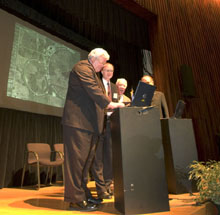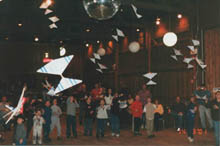 | Monday, March 7, 2005 |
|
Monday, March 7 2:30 p.m. Particle Astrophysics Seminar - Curia II Speaker: M. Zaldarriaga, Harvard University Title: 21 cm Fluctuations: A New Window for Cosmology 3:30 p.m. DIRECTOR'S COFFEE BREAK - 2nd Flr X-Over 4:00 p.m. All Experimenters' Meeting - Curia II Special Topic: Computer Security
Tuesday, March 8 |
|
Extended Forecast |
Secon Level 3 |
|
Monday, March 7 Minestrone Chicken & Mushroom Cheese Steak $4.75 Baked Chicken Enchiladas $3.75 Pasta Primavera $3.75 Smoked Turkey Panini Pesto Mayo $4.75 Assorted Slice Pizza $2.75 Pacific Rim Rice Bowl $4.75 The Wilson Hall Cafe now accepts Visa, Master Card, Discover and American Express at Cash Register #1.
Wilson Hall Cafe Menu |
| Fermilab Today is online at: http://www.fnal.gov/today/ Send comments and suggestions to today@fnal.gov Fermilab Today archive Fermilab Today PDF Version Fermilab Result of the Week archive Fermilab Safety Tip of the Week archive Linear Collider News archive Fermilab Today classifieds Subscribe/Unsubscribe to |
|
Barnstormers Soar with Delta Dart Contest this Wednesday | ||
| ||
|
Come out and test your model airplane building and flying skills!
The Fermilab Barnstormers radio controlled model aircraft club will
hold their annual Delta Dart Indoor Model Airplane Contest this Wednesday,
March 9, at the Village Barn.
The doors open at 5:30 p.m., and the contest will start at approximately 7:00pm. It takes about 45 minutes to build the wood and paper Delta Dart. All pieces are precut and color-coded. A twisted rubber band acts as the power source for this flying spectacle. All materials are provided by the Fermilab Barnstormers free of charge to those under 12 years old, and $1 for those over 12. The contest is divided into two age groups, and the longest flight gets first pick of a wide assortment of prizes. Plan to arrive at 5:30 p.m. to build your "world-beater" model. The Barnstormers will be on hand to lend expert building and flying assistance. "Expect to have a good time and get a taste of the model airplane world that Fermilab has to offer," said Jim Zagel of the Accelerator Division and president of the Fermilab Barnstormers. So what make a good Delta Dart? "In some cases luck," Zagel said. "If you follow the instructions, use an appropriate amount of glue, and have a little luck, your airplane will fly great."
- Eric Bland
|
|
Personal Protective Equipment Controlling a hazard at its source should always be the preferred approach. When this is not possible, Personal Protective Equipment (PPE) can be a good option. However, the PPE must be matched to the hazard. A good system for matching hazards and controls is the Hazard Analysis (HA) chapter in our ES&H manual. In fact, many detailed PPE
When using PPE, make sure that it is properly worn. Foam ear plugs, for example, are troublesome to insert. These should be rolled thin. Pull your ear outward/upward and insert the plug. Hold in place until expanded. Untimely removal of PPE is another problem to keep in mind. Workers have received eye injuries from premature removal of their safety eyewear. In such cases their immediate work is typically complete and the injury stems from a secondary unexpected source. Just because you are using HA-specified PPE does not mean you can ignore your surroundings. If conditions change, so can PPE requirements. A fall-protection lanyard that is effective at 100 ft is probably too long for work at 6 ft. Sometimes combined use of more than one type of PPE can cause a problem. If you have worn safety glasses and ear muffs, you know that the hearing protection seal can be easily compromised. Finally, you should not modify PPE since its protective value is tied to its integrity.
Have a great day and let's work safely all week!
|
|
March 2- March 4 - During this 48 hour period operations established one store, which provided the experiments with approximately 13 hours at 11 minutes of luminosity. - Vacuum leak repaired in TeV - TeV suffered quench in shot setup
Read the Current Accelerator Update |
|
From the Chicago Sun-Times, March 6, 2005 Fermilab beams neutrinos to Minnesota in major experiment by Dan Rozek With the click of a key on a laptop computer, a stream of the tiniest, most mysterious subatomic particles ever discovered flew from a 350-foot-deep tunnel at the Fermi National Accelerator Laboratory near Batavia and slammed into a 6,000-ton stack of steel and plastic plates buried in a Minnesota iron mine.
The neutrinos made the underground, 450-mile journey in about 2.5 milliseconds. But the five-year experiment could yield cataclysmic results, including offering a glimpse of how the universe was born and reshaping our understanding of how it works, scientists said Friday as they formally launched the $170 million research project.
|
|
Upcoming Classes March 15 - Access 2000 Intro March 16 - Excel 2000 Intro March 22 - Access 2000 Intermediate March 23 - Excel 2000 Intermediate March 29 & 30 - Behavioral Interviewing (two consecutive half-days) April 5 - Access 2000 Advanced more information
Fermilab Childrens Summer Day Camp
|


